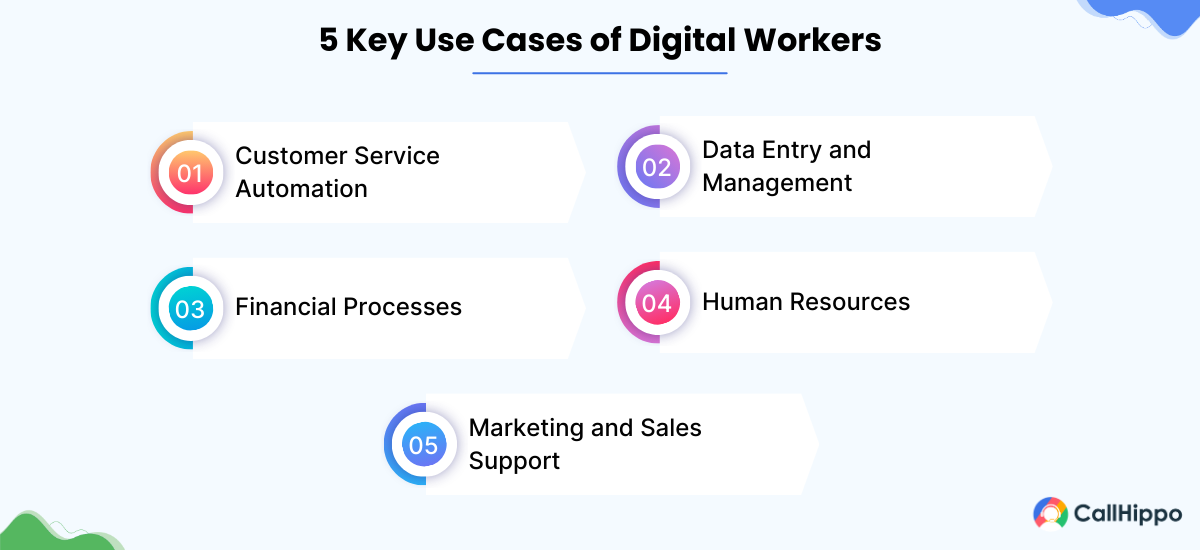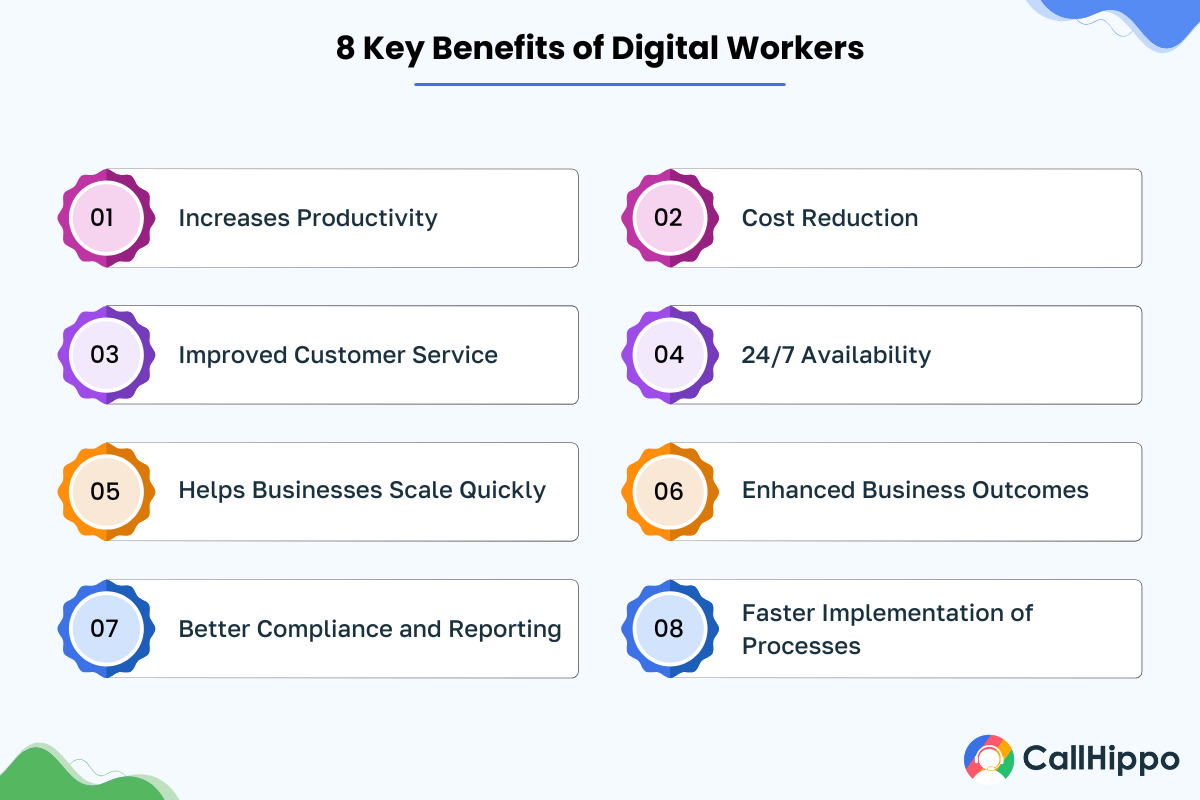As businesses face increasing pressure to improve efficiency, the concept of digital workers is gaining traction. Digital workers are being adopted across sectors like finance and healthcare, where they streamline repetitive and mundane tasks.
By 2030, analysts predict automation will eliminate 29% of jobs while creating 13% of new roles. Businesses that implement digital workers can boost productivity by offloading repetitive tasks and allowing human employees to focus on more strategic work.
In this blog, I will outline practical use cases and the growing importance of digital workers in 2024 and beyond. So let’s get started.
What Is a Digital Worker?
The term “digital worker” has evolved from its original meaning of a human employee with digital skills to now refer to a category of software robots. Unlike digital employees, these digital workers are designed to work alongside human workers and perform specific tasks and processes efficiently.
They take on routine activities and enable human workers to engage in higher-value projects that require critical thinking and innovation. This shift underscores the increasing role of robotic process automation, where digital workers enhance productivity and collaboration within various business functions.
In my experience, investing in training is important when implementing digital workers. Ensure that the training is comprehensive and ongoing so both new and current employees can improve their daily tasks and decision-making process.
What Does a Digital Worker Do?
Digital workers improve operational efficiency in organizations by performing various tasks. They manage repetitive functions, including data entry, transaction processing, and report generation, which ensures a smooth workflow. These software robots can also assist with customer support by answering queries and processing requests, often through chatbots or intelligent virtual assistants. Additionally, digital workers process large datasets using machine learning, recognize patterns, and deliver insights that support decision-making. Automating these tasks reduces errors, saves time, and allows human workers to focus on strategic initiatives that encourage growth and innovation.
Purpose Of Digital Workers
Digital workers are built for a specific purpose: to help people work better and faster. You can think about digital workers as virtual team members who do the boring or repetitive work, while real people do the work that matters most. Here’s a breakdown of the main reasons behind their creation:
1. Creating a Balanced Partnership Between Humans and Technology
Digital workers were not created only to do tasks; they are designed to complement human capability. We are already embarking on a future where technology does not replace people, but rather works with them, adding structure, scale, and logic to people’s flexibility and creativity. This partnership is the basis for a modern, resilient workforce.
2. Helping Employees Escape the Zone of Repetition
After mastering their roles, many employees hit boredom, a lack of challenge, or even burnout. Digital workers relieve them from repetitive tasks so they can move into new, stimulating challenges, keeping motivation and growth alive. This addresses a hidden productivity issue that often goes unnoticed.
3. Enabling Complex, End-to-End Process Execution
These are not simple bots. Digital Workers can handle full workflows from start to finish and even make decisions along the way. Digital workers pull together data, logic, and judgment to perform meaningful, multi-step tasks that once required multiple human hands across multiple departments.
4. Breaking Down Work and Data Silos Across Systems
Many organizations fail because their data is caught in various disconnected systems. Digital workers are designed to cross those silos connecting platforms, uncovering insights, and connecting dots to help teams make better decisions with the entire picture.
5. Plug-and-Play Digital Personas With Cognitive & Analytical Skills
Instead of building automation piece by piece, companies can now deploy ready-made Digital Workers that come with built-in intelligence, capable of transactional tasks, cognitive understanding, and even analytics. This makes sophisticated automation accessible without months of development.
5 Major Use Cases of Digital Workers
Digital workers serve as essential tools across multiple industries and demonstrate their adaptability and impact. Here are five top use cases of digital workers.

1. Customer Service Automation
Digital worker solutions like chatbots and virtual assistants manage customer inquiries and address common issues without requiring human input. This capability enhances response times and improves overall customer satisfaction, providing customers with quick answers and fostering a more positive brand experience.
2. Data Entry and Management
Organizations use digital workers to automate data entry tasks and maintain accuracy and speed. These software robots efficiently extract, validate, and update data in real time while minimizing manual errors. This efficiency enables employees to dedicate less time to repetitive tasks and more time to analyzing data and making informed decisions.
3. Financial Processes
In the finance sector, digital workers streamline various processes, including invoice processing, expense management, and financial reporting. Automating reconciliation tasks allows organizations to conduct financial analysis more swiftly and accurately, which leads to better financial insights and decision-making. This capability helps finance teams stay on top of their budgets and forecasts.
4. Human Resources
Digital workers assist HR departments by taking over routine tasks like screening resumes, onboarding new employees, and processing payroll. By automating these functions, HR professionals can prioritize employee engagement and strategic planning instead of being bogged down by administrative work. This allows HR teams to concentrate more on creating a positive workplace culture.
5. Marketing and Sales Support
Digital workers improve marketing strategies by evaluating customer data and generating insights for focused campaigns. They automate lead generation and follow-up processes, which boosts sales efficiency. This enables businesses to engage leads more effectively and increase conversion rates into loyal customers.
with AI Sales Agent
- Automate lead follow-ups
- Manage customer interactions 24/7
- Boost conversion rates with intelligent insights

Examples of Digital Workforce In Action
Digital workers are virtual team members who are trained to assume entire business processes from beginning to end. Let’s look at five real-life examples of how businesses are using digital workers.
1. Invoice Processing in Accounts Payable
Invoice processing is one of the more repetitive tasks performed in a finance department. Simply receiving suppliers’ invoices, matching them with purchase orders, and making sure they are paid on time is no walk in the park.
A digital accounts payable clerk can handle the process from end to end. For example, in an SAP environment, the digital worker pulls invoices from a variety of formats and sources, extracts the data needed, matches purchase orders that exist in the system, and schedules payments according to the matched purchase orders.
In Oracle systems, a digital accounts payable clerk can also create new supplier profiles. They can update directories, and this is where the time accounted is multiplied by the very nature of how digital workers work, and where the errors are proportionately less, if not eradicated.
2. Automating Accounts Receivable Tasks
Accounts Payable includes tasks like creating invoices, receiving payments, and updating customer files. While these tasks are mostly straightforward and repetitive, they play a critical role in making sure money comes in and that nothing falls through the cracks.
The digital workers efficiently assist the accounts receivable clerk in logging into the system, downloading attachments from emails, checking the accuracy of transactions and reports, adding invoice numbers, creating regular invoices, and creating custom invoices.
3. Cloud IT Administration and User Management
IT teams are overwhelmed with requests to reset passwords, provision cloud environments, and create reports for using a company’s internal systems. This is where digital IT admins come into play. For example:
- A Digital Azure Admin reads support tickets, resets user passwords, and creates Azure instances.
- A Google Cloud Admin handles VM creation, user access, and usage reporting.
- An AWS Admin responds to Zendesk requests, launches EC2 instances, and generates usage reports.
These digital workers help IT departments save time, reduce human errors, and respond to requests faster.
4. Handling Financial Crime Compliance (AML/KYC)
One of the key compliance tasks in the banking/insurance industries involves compliance with Anti-Money Laundering (AML) and Know Your Customer (KYC) rules and regulations, which can be difficult.
The digital workers collect data, investigate, and document findings while reviewing completely different case work. They give the compliance teams support in managing increasing workloads, reliably and rapidly, which is difficult to replicate manually and at scale.
5. Customer Support and Sales Assistance
Customer support and sales teams can be inundated with hundreds of inquiries in a day, most of which are either simple to answer or repetitive. Digital workers can address simple product questions, support order status inquiries, and categorize more complex inquiries to the appropriate department.
Similarly, for sales, digital workers can support an increase in requests for data on clients, responding to follow-ups, and organizing the minutes from meetings. Digital workers can also reduce the number of administrative tasks taking up agents’ time, freeing them up to prioritize high-value conversations.
Differences Between a Bot and a Digital Worker
While the terms “bot” and “digital worker” are often used interchangeably, they refer to different concepts in the realm of automation.
A bot typically focuses on performing specific, predefined tasks, often within a limited scope. Digital workers, on the other hand, are more sophisticated software robots that can handle a broader range of tasks and collaborate with human employees.
Here is a table that highlights the differences in the digital worker vs bot comparison.
| Feature | Bot | Digital Worker |
| Scope of Tasks | Performs specific tasks | Handles a variety of tasks |
| Complexity | Typically simpler | More complex and adaptable |
| Collaboration | Operates independently | Collaborates with humans |
| Technology | Basic automation tools | Advanced AI and ML technologies |
| Learning Ability | Limited learning capability | Learns and improves over time |
| Integration | May have limited integration capabilities | Easily integrates with various systems and applications |
| User Interaction | Primarily interacts through predefined scripts | Engages in dynamic interactions with users, understanding context |
| Error Handling | Basic error handling | Advanced error detection and resolution capabilities |
| Customization | Limited customization options | Highly customizable to fit specific business processes |
| Scalability | May require more effort to scale | Easily scalable to meet increasing demands or tasks |
Benefits of Digital Worker
Digital workers provide various advantages that improve operational efficiency and support business success. Here are the top eight benefits of a digital worker.

1. Increases Productivity
Recent research has found that 85% of people who feel they can be productive everywhere say that they plan to stay with their company for a long time. That is one of the prime benefits of digital workers. Digital workers handle repetitive and mundane jobs, which enables human employees to focus on complex tasks. This not only enhances individual productivity but also improves team dynamics, as employees can dedicate their time and energy to strategic initiatives that require human creativity and critical thinking.
2. Cost Reduction
The automation provided by digital workers reduces dependence on manual labor and leads to substantial cost savings for businesses. Organizations can lower operational costs while maintaining high levels of service quality. Lower labor costs, along with fewer errors and less rework, lead to improved profit margins for businesses.
3. Improved Customer Service
Digital workers give real-time updates to employees and ensure everyone has access to accurate information. This will allow them to offer a more personalized service to each customer and ensure their needs are met. Better customer service, in turn, means your employees will spend less time attending to customers and more time on strategic initiatives.
4. 24/7 Availability
Digital workers can operate around the clock without breaks. This continuous availability ensures that tasks are completed promptly, contributing to improved customer service responsiveness. Businesses can manage inquiries and process requests beyond regular working hours to boost customer satisfaction and loyalty.
5. Helps Businesses Scale Quickly
Digital workers can easily scale operations to meet fluctuating demands. Organizations can add more digital workers to manage increased workloads without requiring extensive hiring. This allows businesses to adapt quickly to seasonal spikes in demand or sudden changes in the market.
6. Enhanced Business Outcomes
Digital workers analyze large datasets effectively, offering valuable insights that guide strategic decision-making. This helps organizations identify trends, discover growth opportunities, and make data-driven decisions that strengthen competitiveness.
Set clear metrics to evaluate digital workers’ impact on productivity and operational efficiency. Identify areas of improvement and make data-driven adjustments as necessary.
7. Better Compliance and Reporting
Digital workers help ensure compliance with regulations by following predefined protocols and maintaining accurate records. This simplifies the reporting process and reduces the risk of non-compliance. Organizations generate reports efficiently, ensuring compliance with regulatory requirements within necessary timeframes.
8. Faster Implementation of Processes
Digital workers can be deployed quickly to support new initiatives or projects. They can seamlessly integrate with current systems and allow businesses to adopt new processes without significant downtime. This helps organizations quickly adapt to market changes and capitalize on emerging opportunities.
Challenges With Digital Workers
Integrating digital workers who perform manual repetitive business functions can certainly support efficiency. But it’s not always plain sailing. Just like when you hire people, hiring your digital workers will come with some challenges.
Let’s consider some of the more practical barriers businesses can face when trying to set up this approach.
1. Not Enough Work to Justify the Cost
Before any new system is implemented, a business should consider: Are there enough functions to be performed to warrant the implementation of the system?
If your team has only a few repetitions tasks, it may not be cost-effective to hire a digital worker. It takes time and cost to implement these systems, and the return needs to be worth the investment made.
2. Trouble Handling Unstructured Information
Digital workers can work with structured data. Structured examples are spreadsheets, forms, or databases that operate on a structured framework.
The problem is that the real world does not adhere to structured data. For example, handwritten notes, open-ended emails, or unstructured PDF files can be challenging for digital workers to work with at all. The freedom of some business processes can discourage businesses when attempting to automate digitally, and can mean your ability to automate, even slightly, could be impacted.
3. High Documentation Effort
In order for digital workers to perform their tasks, they need well-defined instructions. That means someone has to collect the details, define the process, and thoroughly document the activities that are to be performed.
This is not a trivial task. According to the complexity of your operations, building this documentation could be expensive, tedious, and take away your team from more important or valuable work.
4. Scaling Isn’t Always Easy
One of the advantages of digital tools is the statement of performance, indicating that scaling is fairly simple. This only works when the digital worker has been built with a foundation for your business plans to grow.
Suppose it cannot be configured, or it has to be reprogrammed every time you make a change to your process. In that case, you will find you are stuck and may end up spending more time making modifications to the digital worker than enjoying the benefits from having it in the first place.
Conclusion
Digital workers provide a valuable opportunity for businesses to enhance efficiency and drive growth. Through intelligent document processing and effective business process management, organizations can boost productivity and cut costs while improving accuracy and compliance.
The ability to scale operations quickly and analyze data effectively keeps companies competitive.
Moreover, digital transformation technology not only streamlines processes but also allows human workers to concentrate on strategic initiatives. This ultimately leads to a more innovative and agile digital workforce ready to adapt to evolving market demands and seize new opportunities.

Subscribe to our newsletter & never miss our latest news and promotions.









